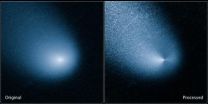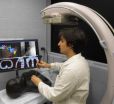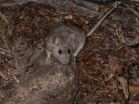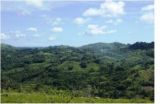(Press-News.org) NASA released Thursday an image of a comet that, on Oct. 19, will pass within 84,000 miles of Mars -- less than half the distance between Earth and our moon.
The image on the left, captured Mar. 11 by NASA's Hubble Space Telescope, shows comet C/2013 A1, also called Siding Spring, at a distance of 353 million miles from Earth. Hubble can't see Siding Spring's icy nucleus because of its diminutive size. The nucleus is surrounded by a glowing dust cloud, or COMA, that measures roughly 12,000 miles across.
The right image shows the comet after image processing techniques were applied to remove the hazy glow of the coma revealing what appear to be two jets of dust coming off the location of the nucleus in opposite directions. This observation should allow astronomers to measure the direction of the nucleus's pole, and axis of rotation.
Hubble also observed Siding Spring on Jan. 21 as Earth was crossing its orbital plane, which is the path the comet takes as it orbits the sun. This positioning of the two bodies allowed astronomers to determine the speed of the dust coming off the nucleus.
"This is critical information that we need to determine whether, and to what degree, dust grains in the coma of the comet will impact Mars and spacecraft in the vicinity of Mars," said Jian-Yang Li of the Planetary Science Institute in Tucson, Arizona.
Discovered in January 2013 by Robert H. McNaught at Siding Spring Observatory, the comet is falling toward the sun along a roughly 1 million year orbit and is now within the radius of Jupiter's orbit. The comet will make its closest approach to our sun on Oct. 25, at a distance of 130 million miles – well outside of Earth's orbit. The comet is not expected to become bright enough to be seen by the naked eye.
The Hubble Space Telescope is a project of international cooperation between NASA and the European Space Agency. NASA's Goddard Space Flight Center in Greenbelt, Md., manages the telescope. The Space Telescope Science Institute (STScI) in Baltimore conducts Hubble science operations. STScI is operated for NASA by the Association of Universities for Research in Astronomy, Inc., in Washington.
INFORMATION:
For images and more information about Hubble, visit:
http://www.nasa.gov/hubble
NASA's Hubble Space Telescope spots Mars-bound comet sprout multiple jets
2014-03-27
ELSE PRESS RELEASES FROM THIS DATE:
New guidance system could improve minimally invasive surgery
2014-03-27
Johns Hopkins researchers have devised a computerized process that could make minimally invasive surgery more accurate and streamlined using equipment already common in the operating room.
In a report published recently in the journal Physics in Medicine and Biology, the researchers say initial testing of the algorithm shows that their image-based guidance system is potentially superior to conventional tracking systems that have been the mainstay of surgical navigation over the last decade.
"Imaging in the operating room opens new possibilities for patient safety and ...
Anti-clotting agent helps reduce the incidence and impact of stent thrombosis during PCI
2014-03-27
WASHINGTON, DC – March 27, 2014 –A new angiographic analysis of the CHAMPION PHOENIX trial examined the incidence and impact of stent thrombosis (ST) in patients undergoing percutaneous coronary intervention (PCI). Results of the study were released today and will be presented March 30 at the American College of Cardiology 63rd Annual Scientific Session.
CHAMPION PHOENIX was a prospective, double-blind, active-controlled trial which randomized 11,145 patients to receive intravenous cangrelor or oral clopidogrel administered at the time of PCI. In a previous analysis presented ...
A tale of 2 species
2014-03-27
A pair of new studies from the Wildlife Conservation Society, Idaho State University, and the University of Nevada Reno look at the surprising variety of factors that prevent two closely related species of woodrats from becoming a single hybrid species despite the existence of hybrid individuals where the two species come into contact.
After finding that two closely related species, the desert and Bryant's woodrats, could interbreed and produce hybrid offspring, scientists set out to determine why only 14 percent of the population in a "contact zone" had genetic signatures ...
Satellite time-lapse movie shows US East Coast snowy winter
2014-03-27
VIDEO:
This new animation of NOAA's GOES-East satellite imagery shows the movement of winter storms from Jan. 1 to Mar. 24 making for a snowier-than-normal winter along the US East Coast...
Click here for more information.
A new time-lapse animation of data from NOAA's GOES-East satellite provides a good picture of why the U.S. East Coast experienced a snowier than normal winter. The new animation shows the movement of storms from January 1 to March 24.
NOAA's Geostationary ...
Food insecurity a growing challenge in Canada's northern and remote Aboriginal communities
2014-03-27
Ottawa (March 27, 2014) – A new expert panel report on food security in Northern Canada, has found that food insecurity among northern Aboriginal peoples requires urgent attention in order to mitigate impacts on health and well-being. Aboriginal Food Security in Northern Canada: An Assessment of the State of Knowledge, released today by the Council of Canadian Academies, addresses the diversity of experience that northern First Nations, Inuit, and Métis households and communities have with food insecurity.
Aboriginal households across Canada experience food insecurity ...
Computing with slime
2014-03-27
Oxford, March 27, 2014 - A future computer might be a lot slimier than the solid silicon devices we have today. In a study published in the journal Materials Today, European researchers reveal details of logic units built using living slime molds, which might act as the building blocks for computing devices and sensors.
Andrew Adamatzky (University of the West of England, Bristol, UK) and Theresa Schubert (Bauhaus-University Weimar, Germany) have constructed logical circuits that exploit networks of interconnected slime mold tubes to process information.
One is more ...
Study finds gaming augments players' social lives
2014-03-27
New research finds that online social behavior isn't replacing offline social behavior in the gaming community. Instead, online gaming is expanding players' social lives. The study was done by researchers at North Carolina State University, York University and the University of Ontario Institute of Technology.
"Gamers aren't the antisocial basement-dwellers we see in pop culture stereotypes, they're highly social people," says Dr. Nick Taylor, an assistant professor of communication at NC State and lead author of a paper on the study. "This won't be a surprise to the ...
People unwilling to swallow soda tax, size restrictions
2014-03-27
ITHACA, N.Y. – Those hoping to dilute Americans' taste for soda, energy drinks, sweetened tea, and other sugary beverages should take their quest to school lunchrooms rather than legislative chambers, according to a recent study by media and health policy experts.
Soda taxes and beverage portion size restrictions were unpalatable to the 1,319 U.S. adults questioned in a fall 2012 survey as part of a study reported online this month in the journal Preventive Medicine.
Adding front-of-package nutrition labels and removing sugary beverages from school environments garnered ...
Agroforestry systems can repair degraded watersheds
2014-03-27
NAIROBI, Kenya. (27 March 2014) ----Agroforestry, combined with land and water management practices that increase agricultural productivity, can save watersheds from degradation.
A study conducted by the World Agroforestry Centre (ICRAF) in the Gabayan watershed in eastern Bohol, Philippines, has shown that agroforestry systems create a more sustainably managed watershed that allows people living there to benefit from the ecosystem. The benefits include higher crop yields, increased income and resilience to climate change.
Agroforestry is an integrated land-use management ...
Scientists watch nanoparticles grow
2014-03-27
This news release is available in German. With DESY's X-ray light source PETRA III, Danish scientists observed the growth of nanoparticles live. The study shows how tungsten oxide nanoparticles are forming from solution. These particles are used for example for smart windows, which become opaque at the flick of a switch, and they are also used in particular solar cells. The team around lead author Dr. Dipankar Saha from Århus University present their observations in the scientific journal Angewandte Chemie – International Edition.
For their investigation, the scientists ...





